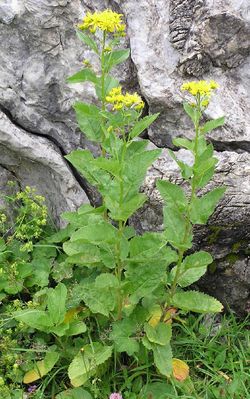Alpine ragwort
| Alpine ragwort | ||||||||||||
|---|---|---|---|---|---|---|---|---|---|---|---|---|

Alpine Ragwort ( Jacobaea alpina ) |
||||||||||||
| Systematics | ||||||||||||
|
||||||||||||
| Scientific name | ||||||||||||
| Senecio alpinus | ||||||||||||
| ( L. ) Moench |
The alpine groundsel ( Jacobaea alpina ), also Alpine ragweed called, is a plant from the genus Jacobaea . It occurs in the Alps.
description

Vegetative characteristics
Alpine ragwort is a perennial herbaceous plant that reaches heights of 30 to 100 centimeters. The most characteristic feature within the genus Jacobaea are the broad, at most 1.5 times as long as wide, and undivided leaves with a clearly heart-shaped base. In contrast to the similar mountain ragwort ( Jacobaea subalpina (WDJKoch) Pelser & Veldkamp ), the petioles of Jacobaea alpina are not winged. The leaf margin is serrated irregularly. On the underside, the leaves are often hairy like a cobweb, but can also be almost bare.
Generative characteristics
The flowering period extends from July to September. The flower heads are in umbrella-like overall inflorescences . The shell of the golden yellow flower head has an outer calyx .
The number of chromosomes is 2n = 20, less often 40.
ecology
The alpine ragwort is a hemicryptophyte . The pollination is carried by flies and moths . It can present itself as invasive , e.g. B. in Norway.
The alpine ragwort is an intensive root and a nitrogen and grazing pointer . In places with intensive grazing , the alpine ragwort can become an annoying and rapidly growing “ weed ”. The cattle avoid the alpine ragwort because the pyrrolizidine alkaloids it contains taste bitter . These alkaloids are liver-toxic to vertebrates and serve to ward off herbivores.
However, they can also help to locate them, because they are scented by the specialized predator, the Jacob wort bear ( Tyria jacobaeae ), in order to find the herb for laying eggs. Most of the pyrrolizidine alkaloids are not toxic to the Jacob wort bear. Mountain farmers use a decoction of the herb to clean wounds.
Occurrence
The range of the alpine ragwort includes France , Germany , Switzerland , Italy and Austria . The alpine groundsel comes in alpine Hochstaudenfluren , alder -Gebüschen or pastures in the Alps at altitudes up to about 2,000 feet in front. The alpine ragwort occurs in the Allgäu Alps near the summit of the Kanzelwand in Bavaria at an altitude of 2030 meters. It can also be found from time to time in higher regions of the Alpine foothills . She prefers nutrient-rich and calcareous soils . It is a character species of the Rumicion alpini association, but also occurs in societies of the Adenostylion, Alno-Ulmion or Agropyro-Rumicion associations.
Taxonomy
The first publication took place in 1753 under the name ( Basionym ) Solidago alpina by Carl von Linné . The new combination to Jacobaea alpina (L.) Moench was published in 1794 by Conrad Moench . Other synonyms for Jacobaea alpina (L.) Moench are: Cineraria alpina (L.) L. , Senecio alpinus (L.) Scop. , Cineraria cordifolia Gouan , Senecio cordifolius (Gouan) Clairv. non L. f. , Senecio cordatus W.DJKoch .
literature
- Manfred A. Fischer, Wolfgang Adler, Karl Oswald: Excursion flora for Austria, Liechtenstein and South Tyrol . 2nd, improved and enlarged edition. State of Upper Austria, Biology Center of the Upper Austrian State Museums, Linz 2005, ISBN 3-85474-140-5 .
Individual evidence
- ↑ a b Senecio alpinus (L.) Scop., Alpine ragwort. In: FloraWeb.de.
- ↑ a b c Werner Greuter (2006+): Compositae (pro parte majore). In: Werner Greuter, E. von Raab-Straube (Ed.): Compositae. : Datasheet Jacobaea alpina In: Euro + Med Plantbase - the information resource for Euro-Mediterranean plant diversity.
- ↑ a b c Erich Oberdorfer : Plant-sociological excursion flora for Germany and neighboring areas . With the collaboration of Angelika Schwabe and Theo Müller. 8th, heavily revised and expanded edition. Eugen Ulmer, Stuttgart (Hohenheim) 2001, ISBN 3-8001-3131-5 , pp. 953 .
- ↑ T. Alm, AM Deschamps, A. Often: The invasive taxon Jacobaea alpina × subalpina in Norway-origin and status. In: Blyttia , 74, No. 2, 2016, pp. 109–117.
- ^ WH Gera Hol, Mirka Marcel, Johannes Avan Veen, Ed van der Meijden: Root damage and aboveground herbivory change concentration and composition of pyrrolizidine alkaloids of Senecio jacobaea. In: Basic and Applied Ecology , 5, No. 3, 2004, pp. 253-260, doi : 10.1016 / j.baae.2003.12.002 .
- ↑ Mirka Macel, Klaas Vrieling:: Pyrrolizidine alkaloids as oviposition stimulants for the cinnabar moth, Tyria jacobaeae. In: Journal of Chemical Ecology , 29, No. 6, 2003, pp. 1435-1446 ( PDF ).
- ↑ Mirka Macel, Peter G. Klinkhamer, Klaas Vrieling, Ed van der Meijden: Diversity of pyrrolizidine alkaloids in Senecio species does not affect the specialist herbivore Tyria jacobaeae. In: Oecologia , 133, No. 4, 2002, pp. 541-550 ( PDF ).
- ↑ Erhard Dörr, Wolfgang Lippert : Flora of the Allgäu and its surroundings. Volume 2, IHW-Verlag, Eching near Munich, 2004, ISBN 3-930167-61-1 . P. 622.
Web links
- Alpine ragwort . In: BiolFlor, the database of biological-ecological characteristics of the flora of Germany.
- Profile and distribution map for Bavaria . In: Botanical Information Hub of Bavaria .
- Senecio alpinus (L.) Scop. In: Info Flora , the national data and information center for Swiss flora . Retrieved May 18, 2016.
- Thomas Meyer: Greiskraut data sheet with identification key and photos at Flora-de: Flora von Deutschland (old name of the website: Flowers in Swabia ).

